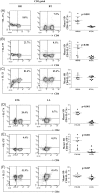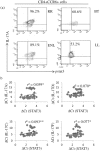Leprosy Reactions Show Increased Th17 Cell Activity and Reduced FOXP3+ Tregs with Concomitant Decrease in TGF-β and Increase in IL-6
- PMID: 27035913
- PMCID: PMC4818038
- DOI: 10.1371/journal.pntd.0004592
Leprosy Reactions Show Increased Th17 Cell Activity and Reduced FOXP3+ Tregs with Concomitant Decrease in TGF-β and Increase in IL-6
Abstract
Background: 50% of leprosy patients suffer from episodes of Type 1/ reversal reactions (RR) and Type 2/ Erythema Nodosum Leprosum (ENL) reactions which lead to morbidity and nerve damage. CD4+ subsets of Th17 cells and CD25+FOXP3+ regulatory T cells (Tregs) have been shown to play a major role in disease associated immunopathology and in stable leprosy as reported by us and others. The aim of our study was to analyze their role in leprosy reactions.
Methodology and principle findings: Quantitative reverse transcribed PCR (qPCR), flowcytometry and ELISA were used to respectively investigate gene expression, cell phenotypes and supernatant levels of cytokines in antigen stimulated PBMC cultures in patients with stable disease and those undergoing leprosy reactions. Both types of reactions are associated with significant increase of Th17 cells and associated cytokines IL-17A, IL-17F, IL-21, IL-23 and chemokines CCL20, CCL22 as compared to matching stable forms of leprosy. Concurrently patients in reactions show reduction in FOXP3+ Treg cells as well as reduction in TGF-β and increase in IL-6. Moreover, expression of many T cell markers, cytokines, chemokines and signaling factors were observed to be increased in RR as compared to ENL reaction patients.
Conclusions: Patients with leprosy reactions show an imbalance in Th17 and Treg populations. The reduction in Treg suppressor activity is associated withhigherTh17cell activity. The combined effect of reduced TGF-β and enhanced IL-6, IL-21 cytokines influence the balance between Th17 or Treg cells in leprosy reactions as reported in the murine models and autoimmune diseases. The increase in Th17 cell associated cytokines may contribute to lesional inflammation.
Conflict of interest statement
The authors have declared that no competing interests exist.
Figures







References
-
- WHO (2014) Weekly epidemiological record. 89: 389–400. - PubMed
-
- Ridley DS, Jopling WH (1966) Classification of leprosy according to immunity. A five-group system. Int J Lepr Other Mycobact Dis 34: 255–273. - PubMed
-
- Nath I, Chaduvula M (2010) Immunological Aspects In: Kar HK KB, editor. IAL Textbook of LEPROSY. First ed New Delhi: Jaypee Brothers Medical Publishers (P) Ltd; pp. 60–73.
-
- Modlin RL (1994) Th1-Th2 paradigm: insights from leprosy. J Invest Dermatol 102: 828–832. - PubMed
-
- Misra N, Murtaza A, Walker B, Narayan NP, Misra RS, et al. (1995) Cytokine profile of circulating T cells of leprosy patients reflects both indiscriminate and polarized T-helper subsets: T-helper phenotype is stable and uninfluenced by related antigens of Mycobacterium leprae. Immunology 86: 97–103. - PMC - PubMed
Publication types
MeSH terms
Substances
LinkOut - more resources
Full Text Sources
Other Literature Sources
Medical
Research Materials

